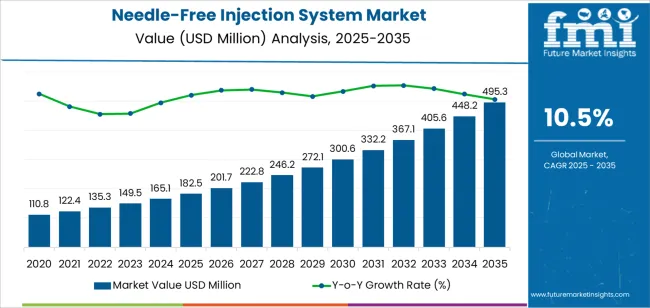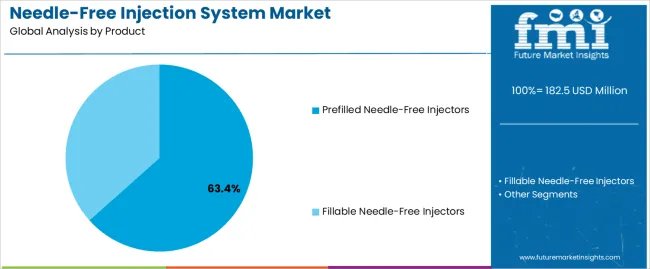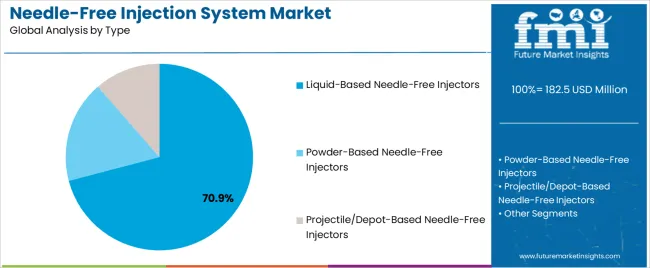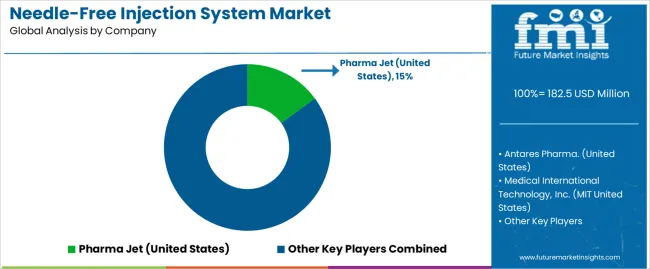The needle-free injection system market is witnessing robust growth, driven by rising demand for pain-free drug delivery and the need to minimize risks associated with needle-stick injuries. Increasing vaccination programs, chronic disease management, and growing adoption in both human and veterinary healthcare sectors are supporting market expansion.
Manufacturers are focusing on developing compact, user-friendly devices with higher precision and reduced drug wastage. Technological advancements in jet-based and spring-powered systems are enhancing patient compliance, particularly in self-administration settings.
The ongoing shift toward minimally invasive procedures, coupled with regulatory encouragement for safer injection alternatives, has further strengthened adoption. As global immunization initiatives expand and biologics gain market traction, needle-free injection systems are positioned to play a key role in improving healthcare delivery efficiency and accessibility across multiple therapeutic areas..

| Metric | Value |
|---|---|
| Needle-Free Injection System Market Estimated Value in (2025 E) | USD 182.5 million |
| Needle-Free Injection System Market Forecast Value in (2035 F) | USD 495.3 million |
| Forecast CAGR (2025 to 2035) | 10.5% |
The market is segmented by Product, Type, Technology, Site Of Delivery, Usability, and Application and region. By Product, the market is divided into Prefilled Needle-Free Injectors and Fillable Needle-Free Injectors. In terms of Type, the market is classified into Liquid-Based Needle-Free Injectors, Powder-Based Needle-Free Injectors, and Projectile/Depot-Based Needle-Free Injectors. Based on Technology, the market is segmented into Jet-Based Needle-Free Injectors, Spring-Based Needle-Free Injectors, Micro Array Patch Injectors, and Others.
By Site Of Delivery, the market is divided into Subcutaneous Injectors, Intra-Dermal Injectors, and Intramuscular Injectors. By Usability, the market is segmented into Disposable Needle-Free Injectors and Reusable Needle-Free Injectors. By Application, the market is segmented into Vaccine Delivery, Insulin Delivery, Pain Management, and Others. Regionally, the market is classified into North America, Latin America, Western Europe, Eastern Europe, Balkan & Baltic Countries, Russia & Belarus, Central Asia, East Asia, South Asia & Pacific, and the Middle East & Africa.

The prefilled needle-free injectors segment leads the product category, accounting for approximately 63.40% share. Its dominance is driven by convenience, dosage accuracy, and reduced preparation time in clinical and home care environments.
Prefilled formats minimize contamination risks and ensure consistent drug delivery, making them ideal for vaccines, insulin, and biologics. The segment’s growth is supported by the increasing trend toward self-administration and the adoption of ready-to-use drug delivery systems.
Pharmaceutical companies are partnering with injector manufacturers to co-develop compatible drug-device combinations, further enhancing demand. With greater emphasis on patient safety and simplified logistics, prefilled needle-free injectors are expected to maintain a leading position in the market..

The liquid-based needle-free injectors segment dominates the type category with approximately 70.90% share, owing to its suitability for delivering precise doses of vaccines, hormones, and therapeutic drugs. The technology enables controlled, high-velocity delivery of liquid formulations through the skin without needles, improving comfort and reducing cross-contamination.
Its adoption has been reinforced by wide applicability across both human and animal health sectors. Continued innovation in pressure regulation and nozzle design has enhanced reliability and dosing accuracy, encouraging healthcare providers to transition from conventional syringes.
As the global focus on infection control intensifies, liquid-based systems are expected to remain the preferred option due to their safety, consistency, and proven clinical performance..

The jet-based needle-free injectors segment holds approximately 67.40% share in the technology category, driven by its efficient drug penetration and high-speed delivery mechanism. The system’s ability to administer precise doses across intradermal, subcutaneous, and intramuscular routes has made it widely accepted in vaccination and therapeutic applications.
Jet-based injectors eliminate the need for sharps disposal, aligning with sustainability and safety goals in healthcare environments. Technological improvements, including adjustable pressure controls and compact designs, have enhanced usability and patient comfort.
With increasing acceptance among healthcare professionals and ongoing integration into mass immunization campaigns, the jet-based injector segment is expected to sustain its leadership throughout the forecast period..
This section provides a detailed analysis of the needle-free injection system market over the past five years and highlights the expected trends in the industry. The market has experienced a substantial historical compound annual growth rate of 19.1% but is gradually becoming more restrictive. The industry is anticipated to grow at an enduring pace of 15.5% CAGR until 2035.
| Historical CAGR | 19.1% |
|---|---|
| Forecast CAGR | 15.5% |
The high upfront expenditures of adopting new technology inquire about its effectiveness and dependability in comparison to conventional injection techniques, and a lack of needle-free substitutes for specific drugs or medical procedures all contribute to a global shortage of needle-free injection systems.
Crucial factors are anticipated to disturb the demand for needle-free injection systems through 2035.
During the predicted duration, market participants are going to need to be shrewd and adaptive, as these perplexing features set the sector up for upcoming accomplishments.
Advancements in Injection Mechanism Shoot up in Global Needle-Free Injection Sector
The healthcare infrastructure has significantly developed needle-free injection systems, with notable advancements in drug delivery mechanisms and user interfaces. These innovations have revolutionized the traditional methods of administering injections, which often inflict pain and discomfort on patients through the use of needles.
The enhanced user interfaces of these methods offer greater convenience and ease of use, making them particularly attractive to patients requiring repeated injections. Concerning these advancements, it is anticipated that over the ensuing decade, the needle-free injection systems market is expected to grow significantly on a global scale.
High Emphasis on Patient Comfort
Needle-free drug delivery devices have been developed in response to consumer desire for easy and painless medication administration techniques.
These cutting-edge substitutes for conventional needle-based procedures provide a more pleasant and minimally intrusive way to dispense medicine. Needlestick injuries and infections are decreased by needle-free systems, which come in various forms and are appropriate for patients of all ages.
Technological developments such as inhalers, jet injectors, and microneedles have made it possible to create more accurate and efficient drug delivery systems for a range of medications, including hormones, insulin, vaccinations, and medicines.
The requirement for self-administration of medicine, the aging population, and the rising incidence of chronic illnesses are all predicted to drive considerable growth in the market for needle-free drug delivery systems.
Expanding Applications in Different Industries
Needlestick-free injection system technology has been developed and found to have new applications outside traditional hospital settings. Due to the technology's application in veterinary medicine and cosmetic operations, the demand for these systems has increased significantly in the healthcare, cosmetic, and veterinary industries.
Patients of all ages can benefit from needle-free medication delivery systems accessible in oral, inhalation, transdermal, and topical forms. These devices help to reduce fear and anxiety, particularly in elderly and pediatric patients. They also save time and money by reducing the risk of infection and requiring fewer medical professionals with training.
Needle-free injection systems are appealing to physicians and patients alike because they offer a safe and painless substitute for conventional needle-based injections. With the rising need for needle-free injection systems in a variety of applications, the needle-free injection systems market is predicted to rise further in the approaching decade.
This section offers in-depth analyses of particular needle-free injection system market sectors. The two main topics of the research are the prefilled needle-free injectors segment and the liquid-based needle-free injectors segment.
This section attempts to provide a profound understanding of these segments and their relevance in the larger context of the needle-free injection system industry through a comprehensive examination.
| Attributes | Details |
|---|---|
| Top Type | Liquid-Based Needle-Free Injectors |
| CAGR from 2025 to 2035 | 15.0% |
From 2025 to 2035, liquid-based needle-free injectors grew at a significant compound annual growth rate (CAGR) of 15.0%, making them the most popular type in the industry. From 2020 to 2025, this fell by 18.6% from the previous CAGR of the liquid-based needle-free injectors type. The evolution of the liquid-based needle-free injectors component segment is described by the following drivers:
| Attributes | Details |
|---|---|
| Top Product | Prefilled Needle-Free Injectors |
| CAGR from 2025 to 2035 | 15.3% |
With a notable CAGR of 15.3% between 2025 and 2035, the prefilled needle-free injectors segment is anticipated to lead the needle-free injection system market. Nevertheless, it is crucial to remember that a stunning 18.9% CAGR was originally predicted for prefilled needle-free injectors. Various factors led to the creation of prefilled needle-free injectors:
This section delves into the needle-free injection system sectors of some of the most influential nations on the global stage, including the United States, China, Japan, South Korea, and the United Kingdom.
A comprehensive investigation is anticipated to explore the factors impacting these countries' demand for, adoption of, and engagement with needle-free injectors. The analysis is expected to provide a detailed understanding of the current state of needle-free vaccine injectors in these nations and their potential for growth in the forthcoming decade.
| Countries | CAGR from 2025 to 2035 |
|---|---|
| United States | 15.1% |
| United Kingdom | 16.5% |
| China | 16.3% |
| Japan | 17.1% |
| South Korea | 12.8% |
With a projected CAGR of 15.1% until 2035, the needle-free injection system market in the United States is predicted to expand significantly in the upcoming years. The sector has already demonstrated tremendous promise, with a remarkable 18.6% CAGR predicted between 2020 and 2025.
The market is expected to be worth USD 113 million, which shows that the healthcare industry has a lot of room to develop and attract investment. The following are some of the main trends:
Up to 2035, the needle-free injection system sector in the United Kingdom is anticipated to expand at a CAGR of 16.5%. This growth rate is lower compared to the CAGR of 21.8% recorded between 2020 and 2025.
Notwithstanding the lackluster expansion, the sector is expected to achieve a worth of USD 495.3 million by 2035. The need for needleless injections is being driven by the following factors, which are probably very important for the industry's growth:
According to forecasts, China's needle-free injection system demand is expected to develop at a potential compound annual growth rate (CAGR) of 16.3% by 2035, valued at USD 110.8 million. Recall that from 2020 to 2025, the country witnessed a higher CAGR of 20.7%. Here are a few of the key developments:
The demand for needle-free injection systems in Japan is soaring dramatically, and the industry is anticipated to grow at a CAGR of 17.1% through 2035, meaning that by that year, it should be valued at around USD 73.4 million globally. The Japanese needle-free injection system industry's prior compound annual growth rate was around 21.6%. Among the main motivators are:
In South Korea, the market for needle-free injection systems is seeing a sharp surge in demand. By 2035, the sector h is expected to expand at a CAGR of 12.8%, which implies that its global valuation could reach around USD 27.7 million. The compound annual growth rate for the needle-free injection system market in South Korea was around 15.8%. Among the primary drivers are:

In the forthcoming decade, several organizations are anticipated to significantly influence the trajectory of the needle-free injection system industry on a global scale. Research institutions such as Medical International Technology are expected to drive innovation through continuous advancements in delivery mechanisms, usability, and safety features.
Regulatory agencies are likely to play a crucial role in establishing guidelines and standards to ensure needle-free injection systems' safety, efficacy, and quality, fostering market growth and widespread adoption.
Healthcare providers are expected to increasingly integrate needle-free injection systems into various medical procedures, expanding their usage and driving market demand.
Pharmaceutical companies like Pharma Jet and Antares Pharma are expected to collaborate with device manufacturers to develop and commercialize needle-free delivery systems for multiple medications, including vaccines and therapeutics.
Furthermore, technology firms such as Bioject Medical Technologies are anticipated to contribute to industry advancement by incorporating innovative features such as AI integration and connectivity, further enhancing the capabilities and usability of needle-free injection systems.
Recent Developments in the Needle-Free Injection System Industry
The global needle-free injection system market is estimated to be valued at USD 182.5 million in 2025.
The market size for the needle-free injection system market is projected to reach USD 495.3 million by 2035.
The needle-free injection system market is expected to grow at a 10.5% CAGR between 2025 and 2035.
The key product types in needle-free injection system market are prefilled needle-free injectors and fillable needle-free injectors.
In terms of type, liquid-based needle-free injectors segment to command 70.9% share in the needle-free injection system market in 2025.






Full Research Suite comprises of:
Market outlook & trends analysis
Interviews & case studies
Strategic recommendations
Vendor profiles & capabilities analysis
5-year forecasts
8 regions and 60+ country-level data splits
Market segment data splits
12 months of continuous data updates
DELIVERED AS:
PDF EXCEL ONLINE
Injection Epoxy Chemical Anchors Market Size and Share Forecast Outlook 2025 to 2035
Injection Blow Molding Machine Market Size and Share Forecast Outlook 2025 to 2035
Injection Molding Machine Market Size and Share Forecast Outlook 2025 to 2035
Injection Moulding Cosmetic Packaging Market Size and Share Forecast Outlook 2025 to 2035
Injection Molding Machines Industry Analysis in India Size, Share & Forecast 2025 to 2035
Injection Pen Market Insights - Growth, Demand & Forecast 2025 to 2035
Injection Bottles Market Analysis – Size, Demand & Forecast 2025 to 2035
Market Share Distribution Among Injection Moulding Cosmetic Packaging Manufacturers
Injection Molded Plastic Market Trends – Growth & Forecast 2024-2034
Injection Molding Polyamide 6 Market Growth – Trends & Forecast 2024-2034
Injection Molding Containers Market
Lip Injection Market Size and Share Forecast Outlook 2025 to 2035
Fuel Injection System Market Growth - Trends & Forecast 2025 to 2035
Micro Injection Molded Plastic Market Size and Share Forecast Outlook 2025 to 2035
Metal Injection Molding (MIM) Parts Market Size and Share Forecast Outlook 2025 to 2035
India Injection Moulders Market – Demand and Growth Forecast 2025 to 2035
Europe Injection Molding Machines Market Size and Share Forecast Outlook 2025 to 2035
Europe Injection Moulders Market Size and Share Forecast Outlook 2025 to 2035
Powder Injection Molding Market Growth – Trends & Forecast 2025 to 2035
Sliding Injection Molding Machines Market Size and Share Forecast Outlook 2025 to 2035

Thank you!
You will receive an email from our Business Development Manager. Please be sure to check your SPAM/JUNK folder too.
Chat With
MaRIA